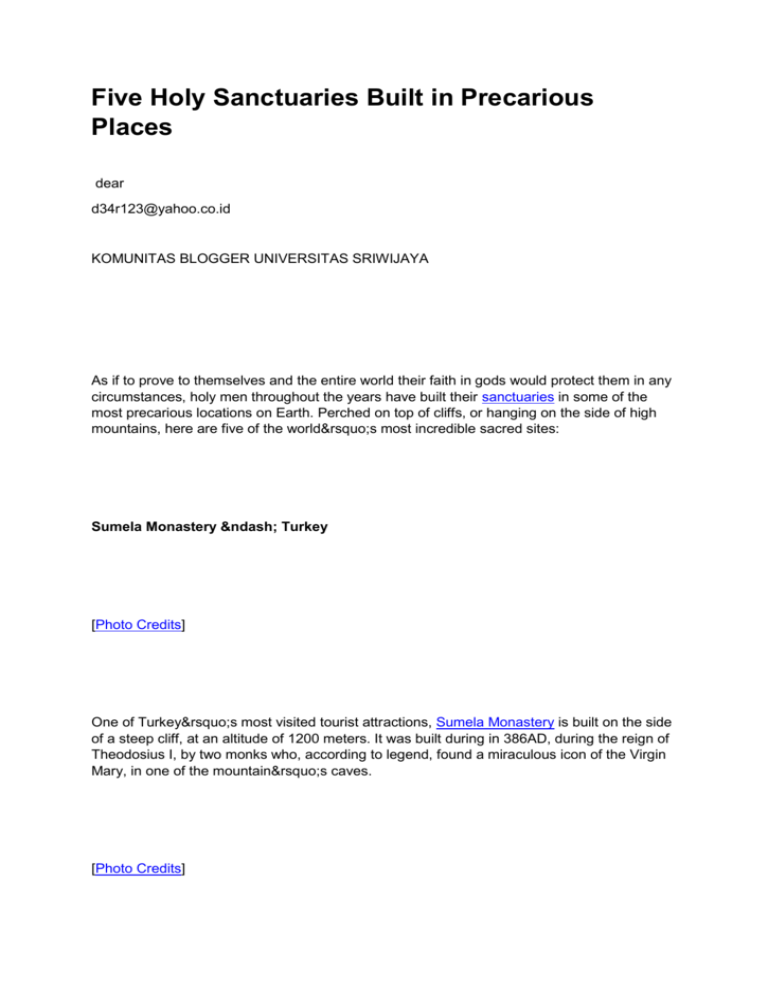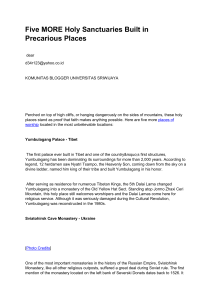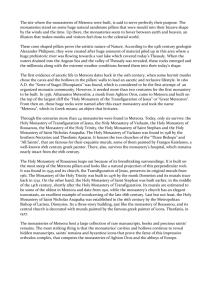Five Holy Sanctuaries Built in Precarious Places
advertisement

Five Holy Sanctuaries Built in Precarious Places dear d34r123@yahoo.co.id KOMUNITAS BLOGGER UNIVERSITAS SRIWIJAYA As if to prove to themselves and the entire world their faith in gods would protect them in any circumstances, holy men throughout the years have built their sanctuaries in some of the most precarious locations on Earth. Perched on top of cliffs, or hanging on the side of high mountains, here are five of the world’s most incredible sacred sites: Sumela Monastery – Turkey [Photo Credits] One of Turkey’s most visited tourist attractions, Sumela Monastery is built on the side of a steep cliff, at an altitude of 1200 meters. It was built during in 386AD, during the reign of Theodosius I, by two monks who, according to legend, found a miraculous icon of the Virgin Mary, in one of the mountain’s caves. [Photo Credits] Sumela had a very turbulent history, it fell into ruins more than once, but it was restored and expanded every time. Its current form dates back to the 14th century, when due to its growing popularity, it was granted imperial funds by emperor Alexios III and Sultan Mehmed II. The monastery was finally abandoned in 1923, during the population exchanges between Greece and Turkey and currently functions only as a tourist attraction. Meteora - Greece [Photo Credits] Meteora (Greek for “suspended rocks”) is one of the most important religious sites in the world and a must-see attraction in Greece. It numbers six monasteries, built on natural rock pillars up to 550 meters tall. Although experts haven’t been able to determine when the monasteries of Meteora were built, evidence shows monks have been living here since the 11th century AD. [Photo Credits] There were originally 20 monasteries, built by monks and pilgrims seeking to escape from the invading Turks, but only six remain standing today. Constructing a monastery on giant sandstone pillars is a seemingly impossible task even in modern times, but the monks managed to build them using extremely long ladders tied together and rope systems. The ropes were replaced only “when the Lord let them break”. In the early 19th century, steps were carved into the rock making the entire complex considerably more accessible. Nowadays, each of the six monasteries is inhabited by fewer than ten people and they mostly act as museums and tourist attractions. Five of the Meteora Monasteries are inhabited by monks and one by nuns. Tiger’s Lair Monastery – Bhutan [Photo Credits] Perched on the side of a cliff, at 3,120 meters above sea level, Tiger’s Nest Monastery overlooks the beautiful Paro valley, in Bhutan. The history of this incredible holy site is tied to the destiny of Guru Rinpoche, one of the most important historical figures of Buthan. Legend has it one of Guru’s consorts transformed herself into a tigress and carried him on her back all the way from Tibet. They landed on a cliff near Paro where Guru Rinpoche entered a cave and meditated for three months. Tiger’s Nest Monastery is built in this holy place. [Photo Credits] Tiger’s Nest Monastery, also known as Paro Taktsang, was built sometime in the 8th century, at 900 meters above Paro Valley. Locals believe the workers were aided by dakinis, magical beings who carried up the building materials. The monastery was damaged during a fire in 1998 and it took the renovation team until 2005 to restore it. Hanging Temple of Hengshan - China [Photo Credits] Literally hanging on the side of Mount Heng, 75 meters above ground, the temple of Hengshan is one of the most popular tourist destinations in the Datong province. Built during the Late Northern Wei Dynasty, over 1,500 years ago, by a monk named Liao Ran, the Hanging Temple has passed the test of time and gravity, sustained only by a few wooden poles. [Photo Credits] This amazing display of architecture is comprised of 40 chambers dug into the cliff and linked together through a network of tunnels. Its uniqueness comes not only from its incredible location, but also from the fact that it hosts three religions, Buddhism, Taoism and Confucianism. Phuktal Monastery - India [Photo Credits] High up in the Himalaya Mountains, on the edge of a cliff, lies one of the most breathtaking monasteries in the world. Built in the 12th century, in a honeycomb style, Phuktal (Phugtal) Monastery is home to 70 Gelug (Yellow Hat) Buddhist Monks. It’s only reachable by foot, with the nearest road a three-days-trek away. [Photo Credits] Phuktal Monastery is located under the entrance of a large grotto, close to a natural spring. It is amazing how a structure built out of mud bricks, wood and stones has lasted so long in such a harsh environment, where temperatures sometimes decrease to 35 degrees Celsius.








